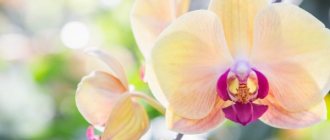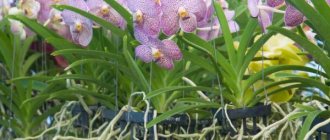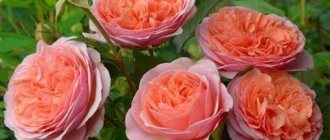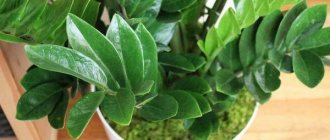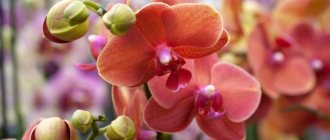The name "Phalaenopsis" translates as "moth-like". But the shapes of buds in representatives of this beautiful, very numerous and very mysterious genus of orchids are very different. The coloring is just as varied. There is a real riot of colors here - from soft pastels to deep dark ones.
If you want to find out more about the shades of phalaenopsis and admire their photos, then read this article. Other materials on our site will help you find out what kind of care, watering and maintenance conditions they require.
How to choose?
The most varied shades of orchids are called orange. Dark yellow with orange tints, orange with tints of red and pink, and scarlet are the shades of the orchid, which is sold under the name orange.
When buying an orange orchid, be vigilant and do not let florists deceive you. They often pass off a painted flower as a real one. Such a plant will either bloom white or die.
When choosing an orchid in a store, pay attention to the roots . Their color should be natural, there should be no puncture under the leaves, on the peduncle or neck of the flower.
Epidendrum pseudoepidendrum (Epidendrum pseudepidendrum)
This representative of the orchid family has small inflorescences consisting of single flowers with a diameter of 4 - 5 cm. The petals are narrow and green. The lip, consisting of three lobes, is orange in color.
Epidendrum varieties with a bright orange color are very popular.:
- Epidendrum rooting (lat. Epidendrum Radicans);
- Epidendrum ibaguense.
Epidendrum Radicans:
Epidendrum ibaguense:
The orange orchid does not have any difficulties in care that are not typical for flowers of a more traditional color. There are both phalaenopsis that are quite feasible for beginners to grow, as well as more exotic and capricious varieties that require experience and special conditions from the gardener.
Varieties with bright colors and their photos
There are a huge number of varieties of orange orchids, but among them there are several species that stand out for their beauty. These flowers are easy to grow at home.
Cattleya
The most beautiful of orange orchids. It has large yellow-red inflorescences and a velvety orange lip. The plant needs temperature changes and abundant watering in summer .
We invite you to watch a video about the Cattleya orchid:
Ascocenda
A hybrid created by crossing Ascocentrum and Vanda plants. The plant has bright orange large inflorescences, which are collected in brushes. Leaves are rich green.
Ascocenda is too picky. It takes a lot of effort to see it bloom and grow it. She needs excellent lighting at least twelve hours a day, sudden changes in temperature.
Particular attention should be paid to the fact that Ascocendra needs to be watered a lot and only with warm water .
We invite you to watch a video about the Ascocendra orchid:
Wanda
Capricious, but popular due to its pure orange color. Needs plenty of sunlight, ventilation and fertilizer. Loves high humidity. The roots must be left open so that they do not rot .
Brassada
Hybrid of Ada Aurantica and Brassia. The bright orange buds of Ada Aurantica were inherited by Brassade. Likes it when it's cool, dark and humid. If you provide it with these conditions, then in the summer you can see how beautifully it will bloom. Her flowers will delight you for more than a month.
Cymbidium
A tall orange orchid whose leaves are long and pointed. From spring to autumn, watering should be plentiful. The soil must not be allowed to dry out. The plant does not need high humidity .
We invite you to watch a video about the Crimbidium orchid:
Top dressing
Feeding different types of orchids does not have any significant nuances and especially does not depend on their color. These plants need frequent feeding, every 2-3 waterings. This is done using special compounds that can be bought at any gardening store.
You should not feed plants when:
- transplant;
- during the period of active flowering;
- plant diseases;
- during the rest period.
Rules of care
The plant will take root if it is installed on a windowsill that faces the west or east. The maximum temperature in summer should not exceed 30ºС, and in winter not less than + 14ºС.
It will be necessary to organize additional lighting if it is cold and dark for the plant on the window in winter.
The soil for planting an orange orchid must be specially prepared. You will need pine bark, wood charcoal and sfangoon moss. Choose a transparent pot for the flower with holes for drainage, because air is important for the roots.
Water the orchid generously with warm water . At low temperatures and when there is little light, watering should be done less often so as not to destroy the plant.
Transfer
To maintain a healthy root system, the orange orchid must be properly replanted after it has finished flowering. Transplant stages :
- When removing a flower from a pot, do not allow severe damage.
- Wash off the lump of earth with water.
- Remove damaged roots.
- Leave stumps when cutting leaves that have dried out.
- Dry the flower for three hours before planting.
Thanks to replanting, the mineral supply will not be depleted, the acidity will not increase, and the plant will avoid poisoning.
general information
All flowers of this variety are monopodial. The leaves are leathery. They reach a length of up to 50 centimeters. Their width usually varies from 5 to 10 cm. Peduncles grow between the leaves, and their length is 80 cm. The flowers are always large, about 5-10 cm. And the number ranges from 3 to 20 pieces. The color is very diverse, for example, white, pink, purple, blue.
This variety of orchids is epiphytes, so the root system is represented by aerial roots, with the help of which, under natural conditions, the flower is attached to trees.
Important. Flowering of Phalaenopsis does not depend on the time of year and sometimes lasts up to 6 months. This variety of Phalaenopsis is unpretentious in care and does not require supernatural efforts to maintain special conditions.
Pests and diseases
Caring for an orange orchid must be correct, otherwise the appearance of pests and diseases will be inevitable. If the leaves of a plant begin to turn yellow, then this is a signal of disease . Yellowness indicates incorrect temperature, insufficient moisture and light. It is not recommended to overcool the flower for a long time. This leads to his death.
If spots appear on the leaves and a specialist identifies a viral disease, then the flower must be destroyed. This will help protect other flowers from viruses that can be spread by insects. Viral diseases are incurable.
Bacterial blotch appears as dark-colored spots and softened leaves. In this case, the sore spots are cut off and cauterized with iodine.
Fungal diseases are soil-borne . They are difficult to treat, so it is better to prevent them. If you constantly ventilate the room, avoid excess moisture, and do not leave water on the leaves, you can prevent such diseases.
When a plant is weakened, it can become infested with mealybugs and aphids. Pests can be destroyed only with those drugs that are recommended for orchids.
How to determine the species by flowers?
There are about 70 main varieties of phalaenopsis and a huge number of artificially bred hybrids, differing from each other in both size and color of flowers.
To size
The division of phalaenopsis by size includes two types:
Tall or standard, including Royal
A striking representative of this variety is the Royal Orchid (Phalaenopsis Royal).
This flower has especially large buds of a white or pinkish hue with a delicate delicate aroma. However, flower shops often sell it with blue or bright blue inflorescences. You should know that this color is created artificially by spraying the plant with special paint. After one such flowering, the Royal Phalaenopsis again returns to its natural shades.
The height of the peduncle of the mini variety is no more than 30 cm, and the flowers and leaves are smaller than those of the standard ones. Phalaenopsis equestris (rosea) is one of the representatives of miniature phalaenopsis with a short (20–30 cm) peduncle bearing from 10 to 15 flowers, the diameter of which is 3 cm, and with oval leaves 10–15 cm long and 7–8 cm wide.
Read more about popular varieties of mini-phalaenopsis here.
By color
Shades of phalaenopsis vary from completely white to rich dark purple, and the color can be either single-colored or two-colored or variegated.
Single-color orchids come in a wide range of colors. The most common are:
There are phalaenopsis whose color is unique and inimitable. One such orchid is Surf Song: its petals have a unique coral yellow color.
Among the varieties of pink phalaenopsis, the most common are: Chengdu, Schiller, Narbonne, Legato.
Multicolor phalaenopsis may have different colors of petals and lips, or differences in shades within one petal. Plants are also characterized by the presence of specks, spots, stripes or various patterns. Possible, most common options:
The most famous multicolor varieties of Phalaenopsis:
Sesame
Sesame. A Dutch variety that reaches a height of 70–80 cm and blooms once every six months for 8 weeks. Flowers with a diameter of 8–10 cm with dense light petals and a contrasting lip are completely dotted with specks of red, brown or purple.
Rainbow
Rainbow. It has a peduncle height of 60 cm and a flower diameter of up to 8 cm. This hybrid with a bright raspberry-orange lip is distinguished by the unusual color of the petals with a rainbow transition from pink to peach, yellow and orange.
Big Ben
Big Bang. A multicolor hybrid up to 15 cm high with a flower diameter of up to 8 cm. The color of the inflorescences is distinguished by a variety of shades from soft pink to almost black purple. The variegated pattern of the petals also contains yellow and cream tones.
Anastasia
Anastasia. Reaches a height of 60 cm and blooms for 2 months with variegated flowers in burgundy or coral-red tones. The T relobed lip has a white nose with a three-pronged “crown” on the upper petal consisting of pink stripes.
Britney
Britney. It blooms for more than two months with magnificent large flowers. The lilac petals are dotted with tiny purple specks, and the contrasting lip is burgundy brown.
Fata Morgana
Fata Mogana. Double-trunked phalaenopsis, reaches a height of 40–50 cm. Dark green elongated leaves from 15 to 25 cm long have a red and white edge along the edges. Flowers with a diameter of 8 cm are distinguished by a variety of colors: petals of light colors (cream, yellow, pinkish, white) are covered with a pattern of burgundy, red or purple color, thicker in the middle and less noticeable at the edges. The color of the lip matches the shade of the picture.
Pamplona
Pamplona. 50–60 cm high, it blooms with variegated flowers, the diameter of which reaches 7–8 cm. The color of the petals is dominated by a blueberry-plum shade with white splashes. Pamplona's lip is pink or lilac.
Multicolor phalaenopsis include varieties such as: Frontera, Manhattan, Ravello, Kimono, Charmer, Parrot, Stone Rose, Liodoro, Cleopatra, Wild Cat. You will learn more about each of these orchids if you follow the link.


